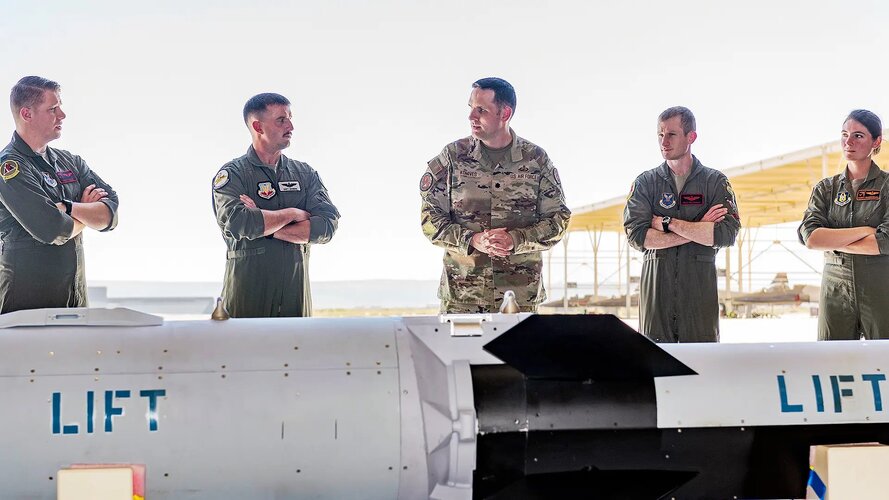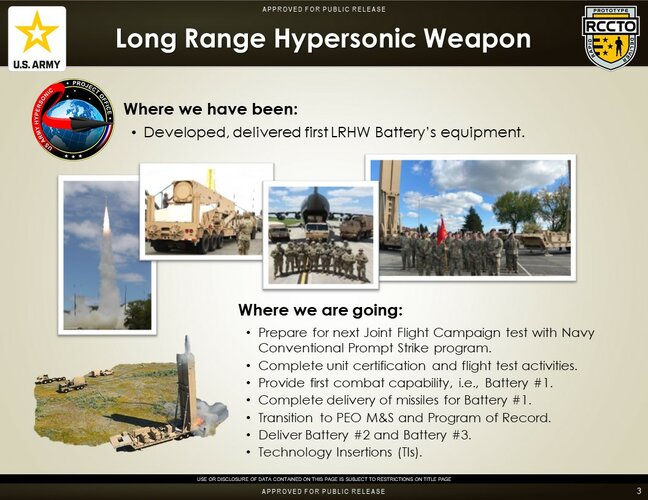You are using an out of date browser. It may not display this or other websites correctly.
You should upgrade or use an alternative browser.
You should upgrade or use an alternative browser.
Current US hypersonic weapons projects. (General)
- Thread starter Hanse
- Start date
Wasn't the proposed flightplan directly through a hurricane that popped up? TBH I can understand that they aborted that launch.
Test Of Dark Eagle Hypersonic Missile At Cape Canaveral Aborted (Updated)
Two Dark Eagle test launches have been abruptly cancelled this year, raising questions about its planned operational debut this year.www.thedrive.com
- Joined
- 3 June 2011
- Messages
- 18,298
- Reaction score
- 12,115
Not without precedent.It would be kind of awkward for there to be a successful test when SecAF and the civilian side of the DAF are requesting termination of the program.
- Joined
- 21 April 2009
- Messages
- 13,728
- Reaction score
- 7,609
- Joined
- 16 April 2008
- Messages
- 9,581
- Reaction score
- 14,393
This is the Long-range Missile Launcher, which is a Mk 70 (four Mk41 cells) on a trailer. Not the same as LRHW.
- Joined
- 21 April 2009
- Messages
- 13,728
- Reaction score
- 7,609

US Army’s Dark Eagle hypersonic weapon fielding delayed to year’s end
“We’re finding problems,” Assistant Secretary of the Army Doug Bush said. “It’s actually good we’re finding these.”
In regards to the Dark Eagle does anyone know what its' tri-services designation will be? Also who's making its' rocket-motors, what are their Mk numbers and are any of their technical specifications known aside from its' diameter (34.5")?
In regards to the Dark Eagle does anyone know what its' tri-services designation will be? Also who's making its' rocket-motors, what are their Mk numbers and are any of their technical specifications known aside from its' diameter (34.5")?
The training canisters had markings indicating a launch weight of 16,300 lbs (20,500 full, 4200 spent). A US Army statement indicated a range of 1750 miles, though that obviously is a gray area - absolute range would probably be when the entire glider fell out of controlled flight, which I would guess would not happen until subsonic speeds. So "range" probably is related to how fast you want the projectile to be moving over the target or even more likely was chosen to include Taiwan from Guam but not extend to the China for political reasons.
Lockheed is the Integrator with Northrop Grumman making the SRMs and Dynetics delivering the CHGB. The SRMs are actually 32.5” in diameter. As to your other questions, someone else will have to answer those.In regards to the Dark Eagle does anyone know what its' tri-services designation will be? Also who's making its' rocket-motors, what are their Mk numbers and are any of their technical specifications known aside from its' diameter (34.5")?
Forest Green
ACCESS: Above Top Secret
- Joined
- 11 June 2019
- Messages
- 9,402
- Reaction score
- 17,134
HyFonic
ACCESS: Restricted
- Joined
- 5 March 2020
- Messages
- 43
- Reaction score
- 135
Can't exactly make out much detail, but this is something we definitely haven't seen before.

 www.thedrive.com
www.thedrive.com



Our First Glimpse Of The Air Force's Hypersonic Cruise Missile
Newly released pictures include the first time the USAF has offered a look at its hypersonic cruise missile design.


Forest Green
ACCESS: Above Top Secret
- Joined
- 11 June 2019
- Messages
- 9,402
- Reaction score
- 17,134
All missiles look huge up close.
That image makes the glider stage look almost cylindrical
It appears to be slightly flattened as though it's a sort of lifting-body.
- Joined
- 3 June 2011
- Messages
- 18,298
- Reaction score
- 12,115
Forest Green
ACCESS: Above Top Secret
- Joined
- 11 June 2019
- Messages
- 9,402
- Reaction score
- 17,134
Something I just noticed looking at the picture in the Drive article more closely - what appears to be the rear fins of the glider have a weird diamond shaped trailing edge that strikes me as an RCS reduction feature. It had occurred to me previously that a wave rider configuration would probably be naturally fairly low radar return, given the chinned nose, very streamlined control surfaces, and overall small size. About the only major reflective feature would be in the intake. The look of those fins make me wonder if a conscious effort was made to reduce the detection range. If you could make the scoop out of composites, or even just the leading edge to allow a metal saw tooth backing (NSM does this), then the overall missile would probably have a very small RCS. If you could delay initial detection down to something like 100mi/150km, that would make HACM enormously difficult to intercept given the short reaction time.
jsport
what do you know about surfing Major? you're from-
- Joined
- 27 July 2011
- Messages
- 7,711
- Reaction score
- 5,716

Ukraine’s Kinzhal intercepts should cool hypersonic hype
The Ukrainian experience with Kinzhal may be a wake-up call for Russia. It should also be a wake-up call for the United States.
- Joined
- 1 April 2006
- Messages
- 11,360
- Reaction score
- 10,132
It's just aerodynamics plus structural strength driven design like fins on ATACMS.Something I just noticed looking at the picture in the Drive article more closely - what appears to be the rear fins of the glider have a weird diamond shaped trailing edge that strikes me as an RCS reduction feature.
- Joined
- 6 August 2007
- Messages
- 3,862
- Reaction score
- 5,811
About the only major reflective feature would be in the intake
When you are designing for low RCS you want to prioritize being as reflective as possible. You want to reflect energy in a way that minimizes what comes back to the receiver.
donnage99
ACCESS: Top Secret
- Joined
- 16 June 2008
- Messages
- 1,353
- Reaction score
- 853
What's the point of RCS shaping at the rear. if you are looking at a hypersonic missile's rear, whatever its intended target is in flame before you could form the next thought of what to do.Something I just noticed looking at the picture in the Drive article more closely - what appears to be the rear fins of the glider have a weird diamond shaped trailing edge that strikes me as an RCS reduction feature.
- Joined
- 21 April 2009
- Messages
- 13,728
- Reaction score
- 7,609

Rocket Lab sees rapid demand for its HASTE hypersonic test vehicle
The Hypersonic Accelerator Suborbital Test Electron vehicle is a modified version of Rocket Lab’s Electron and is designed to support high-speed testing.
- Joined
- 21 April 2009
- Messages
- 13,728
- Reaction score
- 7,609

Air Force Testing Chief: We’re Boosting Hypersonic Test Capacity
The Air Force is increasing hypersonic test capacity in anticipation of a more frequent and aggressive test program, test officials said.
aonestudio
I really should change my personal text
- Joined
- 11 March 2018
- Messages
- 2,961
- Reaction score
- 7,471

DARPA-funded team proposes
Los Angeles CA (SPX) Oct 18, 2023 - In a significant development to overcome the challenges posed by hypersonic missiles, the Defense Advanced Research Projects Agency (DARPA) has turned to an unusual but effective solution: making th
www.space-travel.com
Forest Green
ACCESS: Above Top Secret
- Joined
- 11 June 2019
- Messages
- 9,402
- Reaction score
- 17,134
I think it was only experiemental, i.e. not necessarily intended for a production item.
Scott Kenny
ACCESS: USAP
- Joined
- 15 May 2023
- Messages
- 11,327
- Reaction score
- 13,808
What that article is not seeming to understand is how small the intercept "bucket" is for a hypersonic target. The launcher needs to be very close to the target or hypersonic flight path in order to be able to hit. I've seen drawings that show the defender needs to be within 10km of the target to be able to get a missile in place to hit.
Ukraine’s Kinzhal intercepts should cool hypersonic hype
The Ukrainian experience with Kinzhal may be a wake-up call for Russia. It should also be a wake-up call for the United States.www.c4isrnet.com
This means that basically every possible target needs its own missile battery, you can't cover targets 50 miles away anymore.
Scott Kenny
ACCESS: USAP
- Joined
- 15 May 2023
- Messages
- 11,327
- Reaction score
- 13,808
DARPA is not a production creator. They prove something is possible, but don't have the ability or tendency to push that into a production item.So...did OpFires die? Have heard nothing since.
- Joined
- 3 June 2011
- Messages
- 18,298
- Reaction score
- 12,115
Makes you wonder why they even bothered. If it worked we should use it.I think it was only experiemental, i.e. not necessarily intended for a production item.
Scott Kenny
ACCESS: USAP
- Joined
- 15 May 2023
- Messages
- 11,327
- Reaction score
- 13,808
It's a matter of who controls what parts of budgets, and then someone at Big Army thinking it's cool enough to push for a production contract.Makes you wonder why they even bothered. If it worked we should use it.
- Joined
- 21 April 2009
- Messages
- 13,728
- Reaction score
- 7,609

A New Era for Ceramic Matrix Composites
Hypersonix Development of CMC and UHTCMC has expanded significantly as the U.S. Department of Defense (DOD) seeks to counter threats from hypersonic weapons. Hy
- Joined
- 21 April 2009
- Messages
- 13,728
- Reaction score
- 7,609

US Army ‘highly unlikely‘ to field hypersonic glide weapon this year
Without a major test of the Common Hypersonic Glide Body, the Army's plan to field its hypersonic weapon by the end of the year has slipped away.
- Joined
- 21 April 2009
- Messages
- 13,728
- Reaction score
- 7,609

Army anticipates another delay in fielding Dark Eagle hypersonic weapon after detecting 'problem'
A recent setback in testing makes it is unlikely that the Army will achieve its goal for fielding the Dark Eagle hypersonic missiles by the end of 2023, Doug Bush said.
- Joined
- 21 April 2009
- Messages
- 13,728
- Reaction score
- 7,609

US, Australia eye joint hypersonics experiments in 2024
The countries have been deepening their partnership on hypersonics, according to Heidi Shyu, the Pentagon's chief technology officer.
- Joined
- 21 April 2009
- Messages
- 13,728
- Reaction score
- 7,609

Wild new NASA plasma tech reduces drag during hypersonic flight
The agency claims the technology is 'simpler than conventional methods for control of hypersonic craft.'
- Joined
- 3 June 2011
- Messages
- 18,298
- Reaction score
- 12,115
- Joined
- 21 January 2015
- Messages
- 12,089
- Reaction score
- 16,211
US engine maker GE Aerospace says it has achieved a significant breakthrough in efforts to develop a reusable engine capable of powering ultra-fast hypersonic flight.
GE Aerospace on 14 December revealed that scientists at its Global Research Center in Upstate New York successfully tested a dual-mode ramjet (DMRJ) engine subscale demonstrator that uses a novel technique called rotating detonation combustion (RDC).

GE Aerospace achieves breakthrough in hypersonic engine development
Using a subscale demonstrator, jet turbine manufacturer GE Aerospace successfully ignited a dual-mode ramjet engine using rotating detonation combustion - a technique the company says holds promise for powering crewed hypersonic vehicles.
Similar threads
-
Lockheed Martin AGM-183 Air-Launched Rapid Response Weapon (ARRW)
- Started by Moose
- Replies: 667
-
-
China DF-17 hypersonic boost-glide missile carrier
- Started by antigravite
- Replies: 41
-
-


